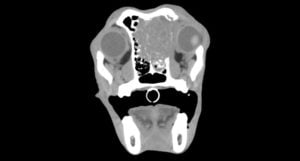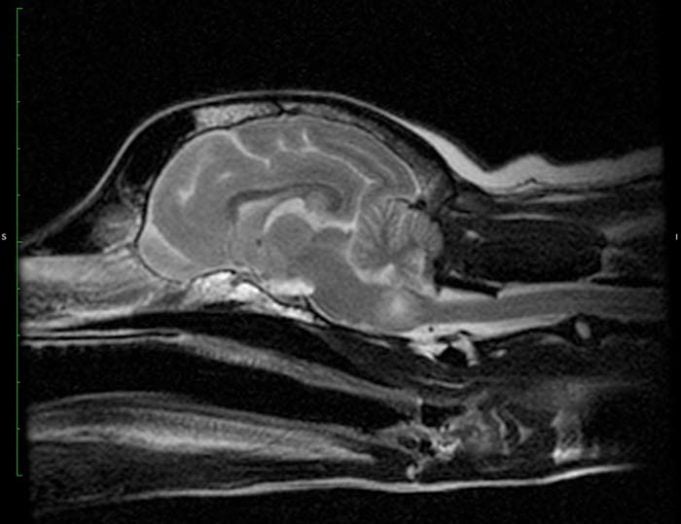Brain tumors are one of many types of tumors that can affect dogs, except it's also one of the most dangerous. Generally, a brain tumor in dogs progresses rapidly, and it’s difficult to discover in its early stages (1, 2).
What Is a Brain Tumor in Dogs?
A tumor is defined as abnormal cell growth. This cell growth can either be benign or malign (cancerous). Because of the specific location, even benign brain tumors can be extremely dangerous since they are often inoperable.
A brain tumor in dogs can be either primary or secondary.
Primary brain tumors develop from cells that are normally found in that specific part of the body. In this particular case, primary brain tumors originate in the brain cells and surrounding membranes. Some of the most common types of primary brain tumors are ones that develop in cells that form the lining of the brain surface (meningioma), the choroid plexus tumor, the lining of the ventricles (ependymoma) and the brain parenchyma (glioma).
Secondary brain tumors are never benign because they originate in another part of the body and then they spread (metastasize) to the dog’s brain. These could start as lung, kidney, skin or other cancer before moving to the brain.

Who’s at Risk?
While any dog can get a brain tumor and there are no specific causes that lead to the development of brain tumors in dogs, some canines are more likely to get it than others.
Age matters and older dogs are more susceptible to brain tumors: studies show that animals over five years of age are at a higher risk, while the median age of affected dogs is nine years (3, 4).
Some breeds are more likely to develop primary brain tumors, too. This is especially true for meningiomas, which are more frequent in dogs with long noses and heads, like Border Collies. On the other hand, dogs with short and flat noses (brachycephalic) are more likely to suffer from tumors that originate in the interstitial tissue of the dog’s central nervous system (gliomas).
Symptoms of Brain Tumors in Dogs
The most common symptom of a brain tumor are seizures, especially if your pooch never had them before and they are older than five years old (5). This includes muscle twitching, drooling, chewing tongue, foaming at the mouth, jerking, collapsing and loss of consciousness.
Other common signs of a brain tumor in dogs include unusual behavior lie aggression, depression or loss of learned behavior, as well as vision loss, changes in water and food intake, anxiousness, nausea, pain in the neck and head (2).
Your dog may also exhibit signs that may not seem related to brain issues, like weight loss or weight gain, wounds that won’t heal or persistent coughing.
How to Diagnose a Canine Brain Tumor?
The only method to diagnose a brain tumor in dogs is tissue biopsy. While imaging tests like ultrasound or X-rays can be used to rule out or locate primary tumors in other body parts that may have spread to the brain, a tissue biopsy is usually the first thing your vet will do in the diagnostic stage.
In some cases, magnetic resonance imaging (MRI) or computed tomography (CT) of the dog's brain are necessary to confirm the diagnosis of brain tumors, or they may be used as precursors for tissue biopsy by some veterinarians.
How to Treat a Dog Brain Tumor?
Depending on the size or stage of the tumor, there are a few treatments available (1).
Radiation Therapy
Traditional radiation therapy often goes hand in hand with chemotherapy. This treatment entails daily anesthesia, usually for five days a week, three weeks in a row. However, radiation therapy is not the safest treatment because it can also kill healthy brain tissue cells, which can lead to serious side effects (6).
In some cases, radiation therapy can lead to shrinking of the tumor to make surgery a viable option where it previously wasn’t possible (7).
Stereotactic Radiation Therapy (SRT)
SRT is a specialized type of radiation therapy that is more accurate and precise, but it's not widely available (8). In fact, only a few veterinary clinics are able to perform this treatment for dog brain tumors, which also means that it is extremely expensive. Unlike standard radiation therapy, SRT only targets tumor cells and not healthy brain cells.
Surgery
Unfortunately, brain surgery for dogs is not as advanced as it is for humans. During this procedure, your dog would be put under anesthesia while the tumor, or at least part of it, is taken out.
This requires cutting-edge technology and highly trained personnel, so brain surgery for dogs is typically very costly and not available everywhere. In addition to this, there could be side effects that include worsening seizures, altered mental activity and surgical complications.
Medical Management
This isn't a treatment but more of a management of the condition that can only extend a dog’s life for a few extra months (9, 10). It includes the usage of steroids like prednisone to reduce the swelling in the dog's brain, as well as anti-seizure medications. Medical management is the least expensive option, which is why the results are only mediocre at best and do not guarantee full recovery.
Prognosis, Living and Management
The prognosis for dogs with brain tumors varies widely, depending on the tumor’s size and type (2, 11). For example, meningiomas have a much better prognosis than invasive brain tumors like glioblastoma or glioma.
Survival times depend on the type of treatment that was chosen as well.
- Medical management alone has a survival time of 2-4 months.
- Surgery alone has a survival time of 6-12 months
- Radiation therapy alone has a survival time of 6-24 months
- Combination of surgery and radiation therapy comes with a life expectancy of 6 months to 3 years.
During and after treatment, routine physical exams are necessary to determine the state of the brain tumor in a dog, and the pet's neurological status.
Conclusion
Brain tumor in dogs is a dangerous, life-threatening condition, even when the tumor is not cancerous. The location of brain tumors is the main problem because they can often be inoperable. Even when they are, surgery is much riskier than with other types of tumors in dogs, and also very expensive.
Depending on the type and size of the tumor, your pet may survive for a few months to a few years. Knowing how to recognize the signs of dog brain tumor can help you make an early diagnosis and improve your pup's chance to live a longer life.














